
Free Riders and Outliers
- Subject:
- Business and Communication
- Material Type:
- Interactive
- Provider:
- Michigan Virtual
- Date Added:
- 06/26/2019

Free Riders and Outliers
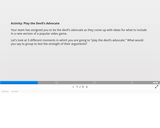
Activity: Play the Devils Advocate

Tony Sarg was a puppeteer and marionette master who invented the first, larger than life, helium balloons for the annual Macy’s Thanksgiving Day Parade. The resource includes a lesson plan/book card, a design challenge, and copy of a design thinking journal that provide guidance on using the book to inspire students' curiosity for design thinking. Maker Challenges include: (1) Dash/Sphero: Develop a Macy’s Day Parade route using tape on the ground with a partner. Then, switch routes with another group and program the robot of your choice to navigate the parade route using code. (2) Ozobot: Develop a synchronized dance routine for both Ozobots for the stage of the Macy’s day parade using https://ozoblockly.com/editor (3) Create a moveable puppet that will be featured in the Macy’s Day Parade.
A document is included in the resources folder that lists the complete standards-alignment for this book activity.

The true, inspiring story of Beauty, the bald eagle, who was shot, rescued, and received a 3D-printed prosthetic beak. The resource includes a lesson plan/book card, a design challenge, and copy of a design thinking journal that provide guidance on using the book to inspire students' curiosity for design thinking. Maker Challenges: (1) Use paper and pencil to design a prosthetic body part for a human or animal. Then use tinkercad.com to create a prototype. Finally, use a 3D printer to print the prosthetic. (2) Have students research animals who use prosthetics. Then, improve the design in Tinkercad and 3D Print.
A document is included in the resources folder that lists the complete standards-alignment for this book activity.
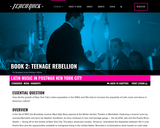
This lesson focuses on Latin American immigration to New York City during the late 1940s and 50s and the effect it had on popular culture. Students investigate a 1940 U.S. Department of Agriculture film about Puerto Rico, a graph containing immigration data, an interview with bandleader Tito Puente, an array of clips featuring Latin dance music, and both mainstream Pop songs and Broadway showtunes revealing the "Latin tinge." As students examine these resources, they will consider and discuss the roles Latino artists played in bringing a Latin feel to American popular culture.
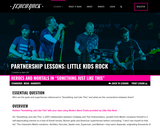
In this lesson, students use the lyrics to "Something Like This" as an opportunity to learn the stories of Achilles, Hercules, Wonder Woman and Superman. Students will explore similarities between these gods and superheroes, finally considering why mortals still need superhumans, thousands of years later.
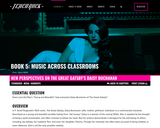
In this lesson, students will explore these questions, comparing Lana Del Rey's "Young and Beautiful" with chapters 1-7 of The Great Gatsby to form their own characterization of Daisy. Students will view the music video for "Young and Beautiful" and analyze advertisements and headlines from 1918-1922 to consider the potential influence of cultural values and gender expectations on women like Daisy. Finally, using excerpts from the novel, the song, and the advertisements, students will work in groups to create an identity chart for Daisy.
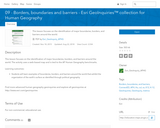
This lesson focuses on the identification of major boundaries, borders, and barriers around the world.

Using scrap metal and spare parts, William Kamkwamba created a windmill to harness the wind and bring electricity and running water to his Malawian village. The resource includes a lesson plan/book card, a design challenge, and copy of a design thinking journal that provide guidance on using the book to inspire students' curiosity for design thinking. Maker Challenge: Develop a way to harness the wind by designing with Strawbees.
A document is included in the resources folder that lists the complete standards-alignment for this book activity.

Ralph Baer’s family fled Nazi Germany for the US when he was a child. Using wartime technology, Baer thought outside the box and transformed the television into a vehicle for gaming. His invention was the birth of the first home console, the Odyssey, a precursor to the Atari gaming system. The resource includes a lesson plan/book card, a design challenge, and copy of a design thinking journal that provide guidance on using the book to inspire students' curiosity for design thinking. Maker Challenges: (1) Think outside the box. What’s something you use everyday, but not for its “intended” purpose? Examples: A broom to clean the snow off your car windshield, a trash bag as a sled. Now, think of a problem you might have at school, home, et al. Invent an item that would solve this problem. (2) Let’s think outside the box! Design the latest and greatest technology for kids to hit the market! Make it the *most* fun anyone has ever had. You may NOT use anything on the market - any technology currently on the market is off limits. Use your imagination, do not put limitations on it, and be as creative as you can. (3) Use household items to create a prototype of your new invention.
A document is included in the resources folder that lists the complete standards-alignment for this book activity.
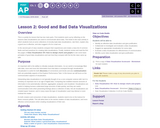
This is a pretty fun lesson that has two main parts. First students warm up by reflecting on the reasons data visualizations are used to communicate about data. This leads to the main activity in which students look at some collections of (mostly bad) data visualizations, rate them, explain why a good one is effective, and also suggest a fix for a bad one.
In the second part of class students compare their experiences and create a class list of common faults and best practices for creating data visualizations. Finally, students review and read the first few pages of **Data Visualization 101: How to design charts and graphs** to see some basic principles of good data visualizations and see how they compare with the list the class came up with.
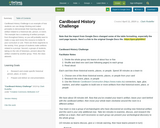
Cardboard History Challenge is an example of how students can use design thinking and maker principles to demonstrate their learning about an artifact related to a historical site, person, or event. The example has a scattering of artifact prompts from throughout history, so you will probably want to make a copy and revise this resource to better fit your curriculum or unit. There are three segments to the activity. First, groups of students make artifacts related to a prompt. Second, a groups of students, taking on the role of historians, present about the artifact created by another group. Third, the class debriefs.

A citizen is someone who is entitled to the legal rights granted by a state, and who is obligated to obey its laws and to fulfill certain duties. Living in the United States does not mean that someone is automatically a citizen. Permanent residents, people who have been lawfully admitted to the United States, are also granted certain legal rights and protections even if they are not citizens. For example, residents can live and work anywhere in the United States, attend public schools, join our armed forces and can also qualify for some Social Security benefits as well. Typically, people who are granted permanent resident status are immigrants who are related by birth or marriage to U.S. citizens or possess important job skills needed in the United States. Unlike citizens, permanent residents may not be able to hold public office or vote in elections. Why should someone consider becoming a citizen if they are not? Check out a list of all of the privileges of citizenship in the United States.

In a letter written to James Madison in 1797, Thomas Jefferson wrote, “The principle of the Constitution is that of a separation of legislative, Executive and Judiciary functions, except in cases specified. If this principle be not expressed in direct terms, it is clearly the spirit of the Constitution…” The separation of powers was one of the fundamental principles of the Constitution’s Framers. The Legislative Branch is sometimes referred as the “people’s branch” since the Founders believed and intended the legislative branch to closely reflect the will of the citizens.
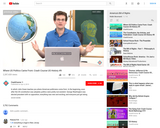
This learning object will have your students understand how important protecting ourselves from government is and how necessary a bill or rights is.
Your students will share a google doc with their group for collaboration on a bill of classroom rights and then come together as a class to choose the top ten rights by having the students vote using surveymonkey.com to allow students to vote via a chromebook or computer. When finished have a class representative present your list of rights to the principal for ratification.

Two blobs of clay go on an enjoyable adventure as they transform themselves into fun shapes and new things throughout their escapade. What will they be by the end of the book? The resource includes a lesson plan/book card, a design challenge, and copy of a design thinking journal that provide guidance on using the book to inspire students' curiosity for design thinking. Maker Challenge: Design a stop-motion video that morphs an item of your choice into another item. Before you begin, sketch out the process you’ll take to transform your item.
A document is included in the resources folder that lists the complete standards-alignment for this book activity.

Students are challenged to design a method for separating steel from aluminum based on magnetic properties as is frequently done in recycling operations. To complicate the challenge, the magnet used to separate the steel must be able to be switched off to allow for the recollection of the steel. Students must ultimately design, test, and present an effective electromagnet.

Chapter 4 is all about civics. While many teachers may be tempted to do this chapter first, it is placed here for a reason. Many of the concepts introduced in Chapters 1-3 are revisited here. Some of the content from 1st grade may serve as a great review at the start of the year.
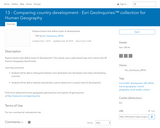
Explore factors that define levels of development.
GeoInquiries are designed to be fast and easy-to-use instructional resources that incorporate advanced web mapping technology. Each 15-minute activity in a collection is intended to be presented by the instructor from a single computer/projector classroom arrangement. No installation, fees, or logins are necessary to use these materials and software.
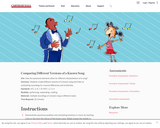
Students create different versions of a known song and listen to contrasting recordings for musical differences and similarities.